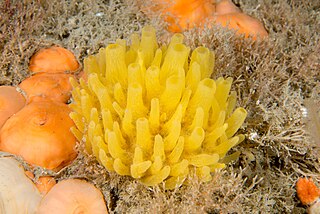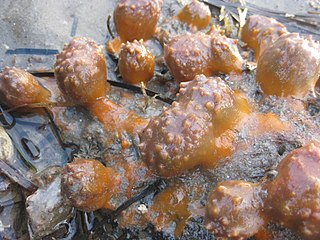Related Research Articles

Demosponges (Demospongiae) are the most diverse class in the phylum Porifera. They include greater than 90% of all species of sponges with nearly 8,800 species worldwide. They are sponges with a soft body that covers a hard, often massive skeleton made of calcium carbonate, either aragonite or calcite. They are predominantly leuconoid in structure. Their "skeletons" are made of spicules consisting of fibers of the protein spongin, the mineral silica, or both. Where spicules of silica are present, they have a different shape from those in the otherwise similar glass sponges. Some species, in particular from the Antarctic, obtain the silica for spicule building from the ingestion of siliceous diatoms.

Polymastia is a genus of sea sponges containing about 30 species. These are small to large encrusting or dome-shaped sponges with a smooth surface having many teat-shaped projections (papillae). In areas of strong wave action, this genus does not grow the teat structures, but instead grows in a corrugated form.
Dame Patricia Rose Bergquist was a New Zealand zoologist who specialised in anatomy and taxonomy. At the time of her death, she was professor emerita of zoology and honorary professor of anatomy with radiology at the University of Auckland.
Acanthopolymastia is a small genus of demosponges belonging to the family Polymastiidae. It has three describe species. These small, bristly, cushion-shaped sponges are only known from deep-sea sites in the southern oceans.
Proteleia tapetum is a species of sea sponge belonging to the family Polymastiidae. It is found in shallow subtidal and intertidal habitats in the far north of North Island, New Zealand.
Polymastia lorum is a species of sea sponge belonging to the family Polymastiidae. It is only known from a single specimen found attached to a dead Glycimeris valve on a reef near Ohinau Island, one of the Mercury Islands off North Island, New Zealand.
Polymastia echinus is a species of sea sponge belonging to the family Polymastiidae. It is only known from shallow subtidal habitats off Te Hāwere-a-Maki / Goat Island in the north of the North Island of New Zealand.
Polymastia crocea is a species of sea sponge belonging to the family Polymastiidae. It is found in subtidal habitats below 6 m depth in the far north of the North Island of New Zealand.
Polymastia rubens is a species of sea sponge belonging to the family Polymastiidae. It is only known from rocky subtidal habitats around Kawau Island off North Island, New Zealand.
Polymastia aurantia is a species of sea sponge belonging to the family Polymastiidae. It is found in intertidal habitats including tide pools in the vicinity of Auckland, New Zealand.
Polymastia pepo is a species of sea sponge belonging to the family Polymastiidae. It is a common species of rocky subtidal and intertidal habitats in the far north of North Island, New Zealand.
Atergia villosa is a species of sea sponge belonging to the family Polymastiidae. It is found in rocky deep-sea habitats around the Chatham Islands, New Zealand.
Acanthopolymastia acanthoxa is a species of sea sponge belonging to the family Polymastiidae. It is a deep-ocean species found on muddy substrates at depths of over 3000 m in the Ross Sea, Antarctica.
Acanthopolymastia bathamae is a species of sea sponge belonging to the family Polymastiidae. It is only known from the Papanui Submarine Canyon off Dunedin, South Island, New Zealand.
Pseudospongosorites is a genus of sea sponges belonging to the family Suberitidae. Currently, the genus is considered as monotypic, consisting of a single species Pseudospongosorites suberitoides. It is found in the Caribbean Sea, the Gulf of Mexico and on the Atlantic coast of the United States as far north as North Carolina. This species is known by the common name Florida hermit crab sponge, so named because hermit crabs often use it as shelter.

Aaptos tentum is a species of sea sponge belonging to the family Suberitidae. The species was described in 1994 by Michelle Kelly-Borges and Patricia Bergquist.
Jean Vacelet is a French marine biologist who specialises in the underwater fauna of the Mediterranean. After earning his licence at the Faculté des Sciences de Marseille and learning to dive in 1954, he specialised in the study of sponges at the Marine station of Endoume, and there he has stayed faithful to both sponges and place for more than half a century. His research has included all aspects of sponges: taxonomy, habitat, biology, anatomy, their bacterial associations, and their place in the evolution of multi-celled animals. He has studied them not only in the Mediterranean but in the Indian Ocean and the Pacific. Exploration of underwater grottoes, together with Jacques Laborel and Jo Hamelin, revealed the existence of sponges dating from very ancient geological periods and the unexpected existence of carnivorous sponges, and surprisingly, the grottoes in some ways mimicked life at much greater depths.
Phyllis Jane Fromont is a New Zealand and Australian scientist specialising in sponges.

Abyssocladia is a genus of the family Cladorhizidae, a family of carnivorous sponges. It is made up of at least 39 species found in oceans all over the world.
Tethya leysae is a species of sea sponge belonging to the family Tethyidae, found in the Canadian north-west Pacific.
References
- ↑ Hyun Bong Park; Nguyen Quoc Tuan; Joonseok Oh; et al. (27 August 2018). "Sesterterpenoid and Steroid Metabolites from a Deep-Water Alaska Sponge Inhibit Wnt/β-Catenin Signaling in Colon Cancer Cells". Marine Drugs . 16 (9): 297. doi: 10.3390/MD16090297 . ISSN 1660-3397. PMC 6164309 . PMID 30150508. Wikidata Q58700110.
- ↑ Astrid Schuster; Andrzej Pisera; Michelle Kelly; Lori J Bell; Shirley A Pomponi; Gert Wörheide; Dirk Erpenbeck (14 March 2018). "New species and a molecular dating analysis of Vetulina Schmidt, 1879 (Porifera: Demospongiae: Sphaerocladina) reveal an ancient relict fauna with Tethys origin". Zoological Journal of the Linnean Society . 184 (3): 585–604. doi:10.1093/ZOOLINNEAN/ZLX114. ISSN 1096-3642. Wikidata Q104454693.
- ↑ Astrid Schuster; Jose V. Lopez; Leontine E Becking; Michelle Kelly; Shirley A Pomponi; Gert Wörheide; Dirk Erpenbeck; Paco Cárdenas (20 March 2017). "Evolution of group I introns in Porifera: new evidence for intron mobility and implications for DNA barcoding". BMC Ecology and Evolution . 17 (1): 82. doi: 10.1186/S12862-017-0928-9 . ISSN 1471-2148. PMC 5360047 . PMID 28320321. Wikidata Q36315237.
- 1 2 3 4 5 "Michelle Kelly". PeerJ. Retrieved 10 March 2022.
- ↑ Kelly, Michelle (1986). Systematics and ecology of the sponges of Motupore Island, Papua New Guinea (Masters thesis). ResearchSpace@Auckland, University of Auckland. hdl:2292/5966.
- ↑ Kelly-Borges, Michelle (1991). The Order Hadromerida (Porifera: Demospongiae), taxonomy and relationships of the major families (Doctoral thesis). ResearchSpace@Auckland, University of Auckland. hdl:2292/1994.
- ↑ Patricia R. Bergquist; Michelle Kelly-Borges (1991). "An evaluation of the genus Tethya (Porifera: Demospongiae: Hadromerida) with descriptions of new species from the Southwest Pacific". The Beagle. 8 (1): 37–72. ISSN 0811-3653. Wikidata Q111172599.
- ↑ P J McCarthy; T P Pitts; G P Gunawardana; M Kelly-Borges; S A Pomponi (November 1992). "Antifungal activity of meridine, a natural product from the marine sponge Corticium sp". Journal of Natural Products . 55 (11): 1664–8. doi:10.1021/NP50089A016. ISSN 0163-3864. PMID 1479383. Wikidata Q28318025.
- ↑ Mark T. Hamann; Paul J. Scheuer; Michelle Kelly-Borges (12 March 2005). "Biogenetically diverse, bioactive constituents of a sponge, order Verongida: bromotyramines and sesquiterpene-shikimate derived metabolites". The Journal of Organic Chemistry . 58 (24): 6565–6569. doi:10.1021/JO00076A012. ISSN 0022-3263. Wikidata Q110068893.
- ↑ Michelle Kelly-Borges; Patricia R. Bergquist (October 1994). "A redescription of Aaptos aaptos with descriptions of new species of Aaptos (Hadromerida: Suberitidae) from northern New Zealand". Journal of Zoology: Proceedings of the Zoological Society of London. 234 (2): 301–323. doi:10.1111/J.1469-7998.1994.TB06077.X. ISSN 0952-8369. Wikidata Q99975317.
- ↑ Michelle Kelly-Borges (January 1995). "Sponges out of their depth" (PDF). Nature . 373 (6512): 284–284. doi:10.1038/373284A0. ISSN 1476-4687. Wikidata Q60072854.
- ↑ Lévy, Claude, ed. (1998). Sponges of the New Caledonian Lagoon (PDF). Paris: Institut Français de Recherche Scientifique pour le Développement en Coopération. p. 14. Retrieved 10 March 2022.
- ↑ "Michelle Kelly-Borges, University of Hawaii System – Dimensions". app.dimensions.ai. Retrieved 9 March 2022.
- ↑ "A who's who in studies on Porifera". 6 December 2001. Retrieved 10 March 2022.
- ↑ Henry M. Reiswig; Martin Dohrmann; Michelle Kelly; Sadie Mills; Peter J. Schupp; Gert Wörheide (17 September 2021). "Rossellid glass sponges (Porifera, Hexactinellida) from New Zealand waters, with description of one new genus and six new species". ZooKeys . 1060: 33–84. doi: 10.3897/ZOOKEYS.1060.63307 . ISSN 1313-2989. PMC 8463523 . Wikidata Q108607680.
- ↑ Van Soest RW, Boury-Esnault N, Hooper JN, Rützler K, de Voogd NJ, de Glasby BA, Hajdu E, Pisera AB, Manconi R, Schoenberg C, Janussen D, Tabachnick KR, Klautau M, Picton B, Kelly M, Vacelet J (eds.). "Aaptos tenta Kelly-Borges & Bergquist, 1994". World Porifera database. World Register of Marine Species . Retrieved 9 March 2022.
- ↑ Van Soest RW, Boury-Esnault N, Hooper JN, Rützler K, de Voogd NJ, de Glasby BA, Hajdu E, Pisera AB, Manconi R, Schoenberg C, Janussen D, Tabachnick KR, Klautau M, Picton B, Kelly M, Vacelet J (eds.). "Abyssocladia carcharias Kelly & Vacelet, 2011". World Porifera database. World Register of Marine Species . Retrieved 9 March 2022.
- ↑ Michelle Kelly; Jean Vacelet (26 July 2011). "Three new remarkable carnivorous sponges (Porifera, Cladorhizidae) from deep New Zealand and Australian (Macquarie Island) waters". Zootaxa . 2976 (1): 55. doi:10.11646/ZOOTAXA.2976.1.4. ISSN 1175-5334. Wikidata Q97567245.
- ↑ Jon Thomassen Hestetun; Hans Tore Rapp; Shirley Pomponi (10 July 2019). "Deep-Sea Carnivorous Sponges From the Mariana Islands". Frontiers in Marine Science. 6. doi: 10.3389/FMARS.2019.00371 . ISSN 2296-7745. Wikidata Q104457959.
- ↑ Kelly, Michelle (2011). Taxonomy and systematics of the Porifera: contributions and technical applications (DSc). University of Auckland. Retrieved 11 March 2022.